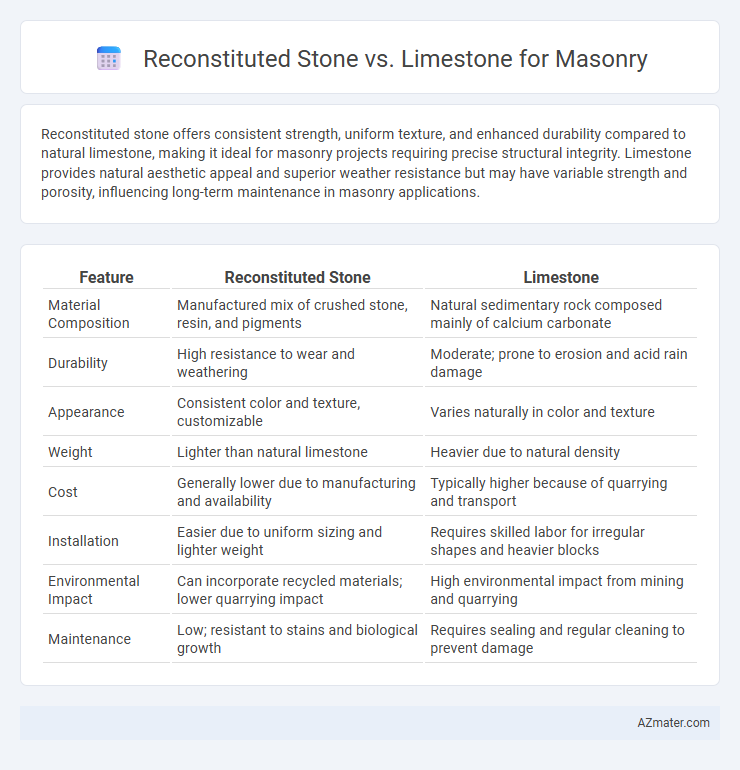Reconstituted stone offers consistent strength, uniform texture, and enhanced durability compared to natural limestone, making it ideal for masonry projects requiring precise structural integrity. Limestone provides natural aesthetic appeal and superior weather resistance but may have variable strength and porosity, influencing long-term maintenance in masonry applications.
Table of Comparison
| Feature | Reconstituted Stone | Limestone |
|---|---|---|
| Material Composition | Manufactured mix of crushed stone, resin, and pigments | Natural sedimentary rock composed mainly of calcium carbonate |
| Durability | High resistance to wear and weathering | Moderate; prone to erosion and acid rain damage |
| Appearance | Consistent color and texture, customizable | Varies naturally in color and texture |
| Weight | Lighter than natural limestone | Heavier due to natural density |
| Cost | Generally lower due to manufacturing and availability | Typically higher because of quarrying and transport |
| Installation | Easier due to uniform sizing and lighter weight | Requires skilled labor for irregular shapes and heavier blocks |
| Environmental Impact | Can incorporate recycled materials; lower quarrying impact | High environmental impact from mining and quarrying |
| Maintenance | Low; resistant to stains and biological growth | Requires sealing and regular cleaning to prevent damage |
Introduction to Masonry Materials
Reconstituted stone offers a consistent texture and color profile, making it ideal for precise masonry applications where uniformity is crucial. Limestone, a natural sedimentary rock, provides timeless durability and unique veining that enhances the aesthetic appeal of traditional masonry projects. Selecting between reconstituted stone and limestone depends on factors like cost, environmental impact, and the desired architectural finish.
What is Reconstituted Stone?
Reconstituted stone is an engineered masonry material crafted by combining crushed natural stone with cement, polymers, and pigments to mimic the appearance and texture of natural stone while offering enhanced durability and uniformity. Unlike natural limestone, reconstituted stone allows for precise control over color, density, and shape, making it ideal for architectural applications requiring consistency and customizability. This material also provides improved resistance to weathering and reduced maintenance compared to traditional limestone, making it a practical choice for both structural and decorative masonry projects.
Understanding Natural Limestone
Natural limestone, a sedimentary rock composed primarily of calcium carbonate, offers unique variations in texture, color, and durability for masonry applications. Its porosity and fossil content contribute to natural aesthetic appeal and weathering characteristics, making it ideal for historic restorations and high-end architectural finishes. In contrast, reconstituted stone replicates these qualities using crushed limestone and binding agents, providing uniformity and enhanced structural strength but lacking the natural variability prized in genuine limestone.
Composition and Manufacturing Differences
Reconstituted stone is manufactured using crushed natural stone combined with resins and pigments, allowing for consistent color and texture, whereas limestone is a natural sedimentary rock primarily composed of calcium carbonate formed through the accumulation of marine organisms. The manufacturing process of reconstituted stone involves molding and curing under controlled conditions, providing enhanced durability and customization options compared to quarried limestone, which is cut and shaped from solid stone blocks. These differences in composition and production result in reconstituted stone offering more predictable performance and design flexibility in masonry applications compared to the variable properties of natural limestone.
Durability and Weather Resistance
Reconstituted stone offers enhanced durability and superior weather resistance compared to natural limestone, as it is engineered to withstand freeze-thaw cycles and resist erosion effectively. Limestone, while aesthetically appealing, tends to be more porous and susceptible to acid rain and environmental wear over time. For masonry projects requiring long-term resilience in harsh climates, reconstituted stone provides a more reliable choice, reducing maintenance and repair costs.
Aesthetic Appeal and Design Versatility
Reconstituted stone offers greater aesthetic appeal and design versatility compared to natural limestone due to its customizable color, texture, and shape options that can mimic various stone types while maintaining uniformity. Limestone provides classic, natural beauty with distinctive grain and weathering patterns that age gracefully, but its design options are limited by natural quarry variations. Reconstituted stone's engineered consistency allows for a wider range of architectural styles and intricate detailing, ideal for contemporary masonry projects seeking both durability and creative expression.
Sustainability and Environmental Impact
Reconstituted stone offers enhanced sustainability through the use of recycled materials and lower carbon emissions in production compared to natural limestone, which involves extensive quarrying and habitat disruption. Limestone extraction contributes to significant environmental degradation, including landscape alteration and increased carbon footprint due to heavy mining equipment. Choosing reconstituted stone reduces resource depletion and waste, making it a more environmentally responsible option for masonry projects focused on minimizing ecological impact.
Cost Comparison: Reconstituted Stone vs Limestone
Reconstituted stone typically offers a more cost-effective option compared to natural limestone due to lower material and production expenses, making it attractive for large-scale masonry projects. Limestone's extraction, quarrying, and finishing processes contribute to higher costs, which can significantly impact overall project budgets. When considering long-term maintenance and durability, reconstituted stone often presents better value without compromising the aesthetic appeal of natural limestone in masonry applications.
Maintenance Requirements
Reconstituted stone requires less maintenance than natural limestone due to its engineered durability and resistance to weathering, staining, and cracking. Limestone, being a natural sedimentary rock, is porous and more susceptible to moisture absorption, necessitating regular sealing and cleaning to prevent deterioration. For masonry projects, selecting reconstituted stone reduces long-term upkeep costs and preserves structural integrity with minimal intervention.
Choosing the Best Material for Your Masonry Project
Reconstituted stone offers consistent density, shape, and color, making it ideal for precision masonry projects requiring uniformity and durability. Limestone provides natural beauty and unique textures but can vary in hardness and weather resistance, influencing long-term maintenance needs. Selecting between reconstituted stone and limestone depends on desired aesthetic, structural requirements, and budget constraints for optimal masonry performance.

Infographic: Reconstituted stone vs Limestone for Masonry
 azmater.com
azmater.com